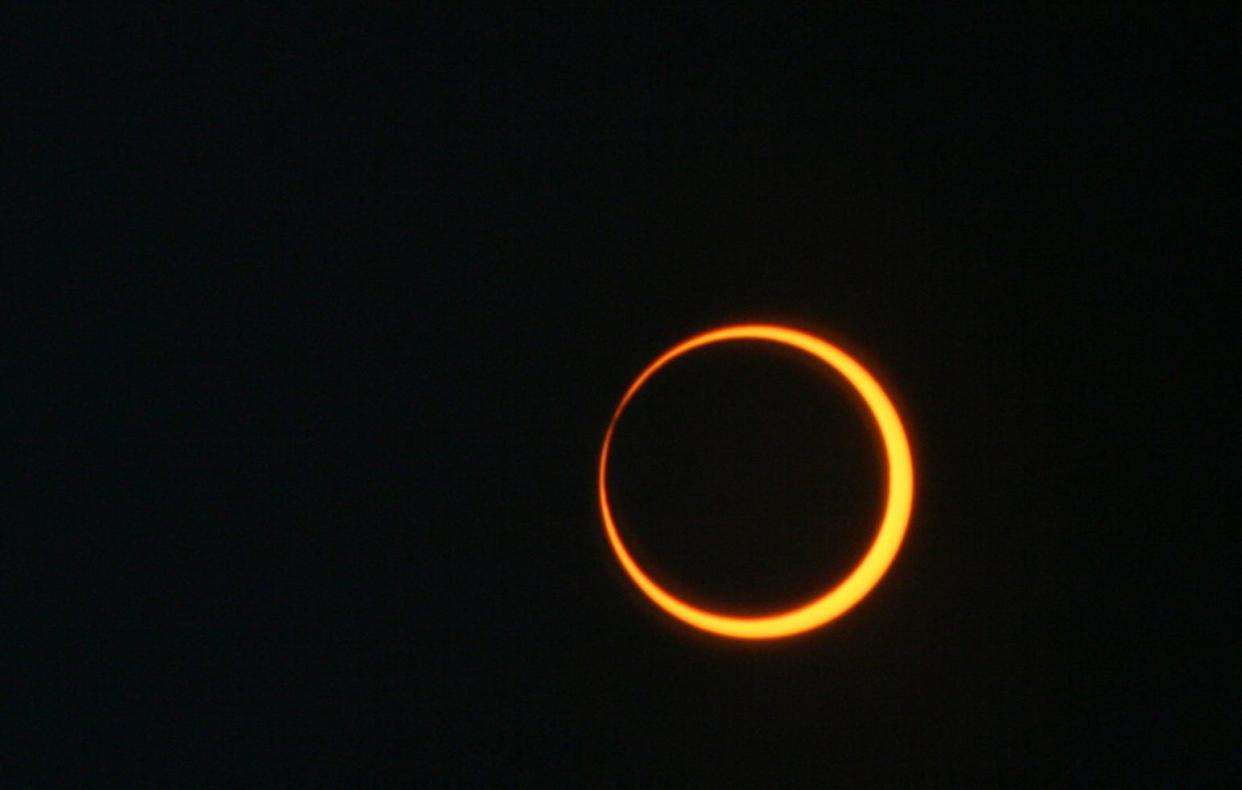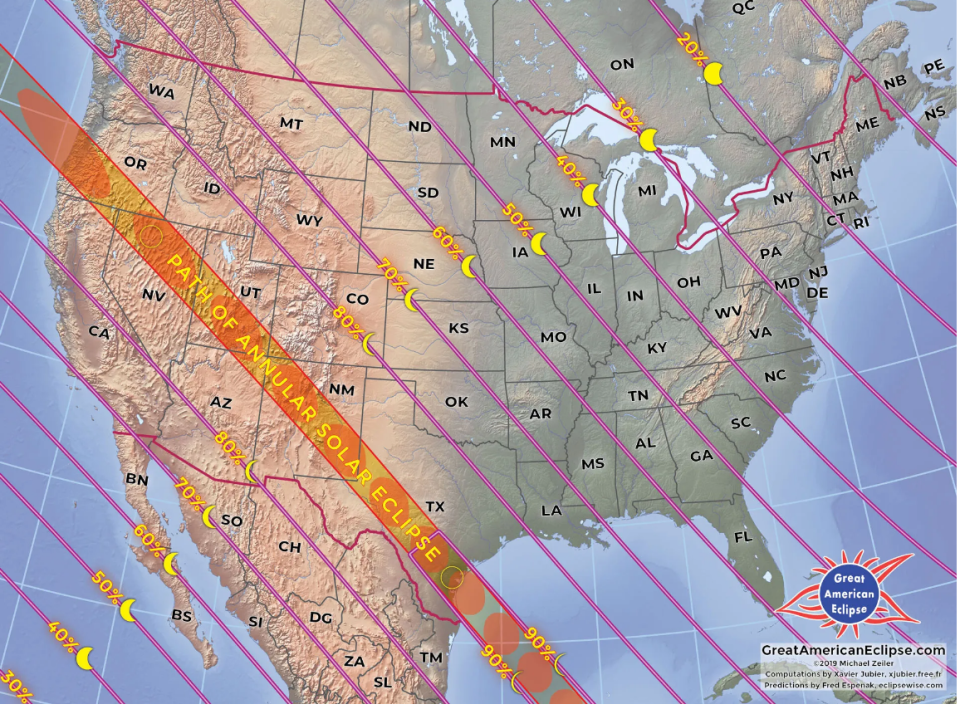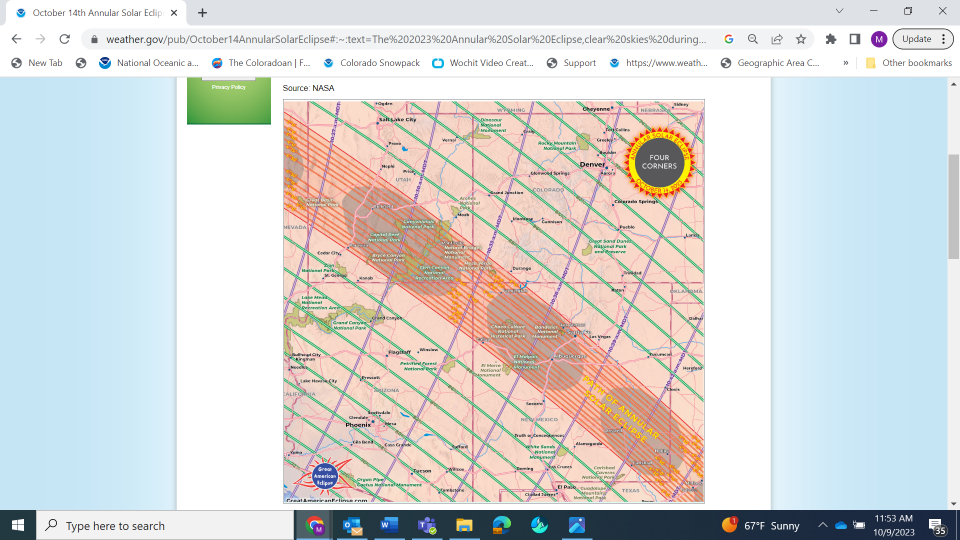'Ring of fire' eclipse: What you need to know in Colorado to see rare event Oct. 14

The most hyped event since Travis Kelce's courtship of Taylor Swift takes place Oct. 14 with the much-anticipated "ring of fire'' annular solar eclipse.
Here's what you need to know about the big event, including best eclipse viewing sites, when to view and how to safely view, according to NASA and other sources, including National Eclipse and Great American Eclipse:
What is an annular solar eclipse and how is it different than a total solar eclipse?
An annular solar eclipse happens when the moon passes between the sun and Earth while it is at its farthest point from Earth. Because the moon is farther away from Earth, it appears smaller than the sun and does not completely cover it, instead creating what looks like a ring of fire around the moon.
A total solar eclipse happens when the moon passes between the sun and Earth at a distance that completely blocks the face of the sun.
How rare is an annular solar eclipse?
After this month's event, the next annular eclipse visible for those in the U.S. takes place June 21, 2039.
The next total solar eclipse visible in the U.S. takes place April 8, 2024, as it crosses from Texas to Maine.
Will the annular solar eclipse be visible in Fort Collins?
Not really.
The track of the full annular eclipse is farther south. Fort Collins will be around 75%-80%, which will result in a partial solar eclipse.
You can view the full annular eclipse from NASA's YouTube channel at www.youtube.com/watch?v=LlY79zjud-Q.

Where are sites closest to Fort Collins to see the full annular eclipse?
Albuquerque, New Mexico is the closest city to see the full annular eclipse. Other western major cities to see the full annular eclipse are San Antonio, Texas, and Eugene, Oregon.
In Colorado's far southwest corner, including Cortez and National Park Service sites such as Mesa Verde, Hovenweep and Canyons of the Ancients, viewing will be 90% of the eclipse.

What time of day can you see the annular solar eclipse?
Times vary depending on location.
In Albuquerque, the partial eclipse begins at 9:13 a.m. MDT. At 10:34 a.m., annularity begins; 10:35 a.m. maximum eclipse; 10:39 a.m., annularity ends and 12:09 p.m. partial eclipse ends.
In southwestern Colorado, maximum eclipse is 10:31 a.m. and lasts just less than 3 minutes.
Make sure to check the weather forecast for the site from which you will view the annular solar eclipse
You will need a clear view to take in the show.
Check with the National Weather Service or other weather sites, especially within three days of the Oct. 14 eclipse, for a more detailed forecast.
How dark will it get on the day of the annular solar eclipse?
In the path of annularity, almost 90% of the sun will be blocked by the moon. It will be similar to sunrise or sunset and you might feel a slight change in the temperature.
Looking at the annular solar eclipse with the naked eye can cause damage. Here are safety tips.
Never look directly at the sun without proper eye protection, as it is harmful to your eyes at any time during an annular eclipse.
Regular sunglasses, no matter how dark tinted, are not safe to view.
Eclipse glasses are the best option. Be sure they are made by companies recommended by the American Astronomical Society and NASA certified. These glasses should have the International Organization for Standardization icon and must have the ISO reference number 12312-2.
Always inspect your eclipse glasses or handheld viewer before use. If torn, scratched or otherwise damaged, discard the device.
Without eclipse glasses, a simple and safe way to view the eclipse is to watch the sun's image projected onto a piece of paper. Poke a small hole in an index card with a pencil point, face it toward the sun and hold a second card 3 or 4 feet behind it in its shadow. You will see a projected image of the sun on the second card.
Do not look at the sun through a camera lens, telescope, binoculars, or any other optical device while wearing eclipse glasses or using a handheld solar viewer, as the concentrated solar rays will burn through the filter and cause serious eye injury. These require different types of solar filters that attach to the front of the device.
This article originally appeared on Fort Collins Coloradoan: 2023 'Ring of fire' annular eclipse: Where, when to view in Colorado

